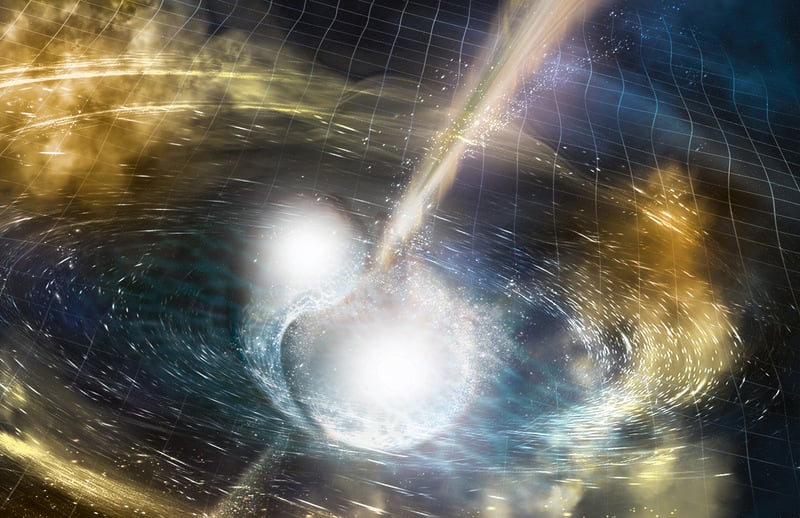In
August of 2017
, another major breakthrough occurred when the
Laser Interferometer Gravitational-Wave Observatory
(LIGO) detected waves that were believed to be caused by a neutron star merger. Shortly thereafter, scientists at LIGO,
Advanced Virgo
, and the
Fermi Gamma-ray Space Telescope
were able to determine where in the sky this event (known as a kilonova) occurred.
This source, known as GW170817/GRB, has been the target of many follow-up surveys since it was believed that the merge could have led to the
formation of a black hole
. According to
a new study
by a team that analyzed data from NASA's
Chandra X-ray Observatory
since the event, scientists can now say with greater confidence that the merger created a new black hole in our galaxy.
The study, titled "
GW170817 Most Likely Made a Black Hole
", recently appeared in
The Astrophysical Journal Letters.
The study was led by David Pooley, an assistant professor in physics and astronomy at Trinity University, San Antonio, and included members from the University of Texas at Austin, the University of California, Berkeley, and Nazarbayev University's Energetic Cosmos Laboratory in Kazakhstan.
[caption id="attachment_139378" align="aligncenter" width="525"]
Illustration of the kilonova merger (top), and the resulting object (left and right) over time. Credit: NASA/CXC/Trinity University/D. Pooley et al. Illustration: NASA/CXC/M.Weiss
[/caption]
For the sake of their study, the team analyzed X-ray data from Chandra taken in the days, weeks, and months after the detection of gravitational waves by LIGO and gamma rays by NASA's Fermi mission. While nearly every telescope in the world had observed the source, X-ray data was critical to understanding what happened after the two neutron stars collided.
While a Chandra observation two to three days after the event failed to detect an X-ray source, subsequent observations taken 9, 15, and 16 days after the event resulted in detections. The source disappeared for a time as GW170817 passed behind the Sun, but additional observations were made about 110 and 160 days after the event, both of which showed significant brightening.
While the LIGO data provided astronomers with a good estimate of the resulting object's mass after the neutron stars merged (2.7 Solar Masses), this was not enough to determine what it had become. Essentially, this amount of mass meant that it was either the most massive neutron star ever found or the lowest-mass black hole ever found (the previous record holders being four or five Solar Masses). As Dave Pooley explained in a NASA/Chandra
press release
:
[caption id="attachment_139380" align="aligncenter" width="580"]
Illustration of the resulting black hole caused by GW170817. Credit: NASA/CXC/M.Weiss
[/caption]
If the neutron stars merged to form a heavier neutron star, then astronomers would expect it to spin rapidly and generate and very strong magnetic field. This would have also created an expanded bubble of high-energy particles that would result in bright X-ray emissions. However, the Chandra data revealed X-ray emissions that were several hundred times lower than expected from a massive, rapidly-spinning neutron star.
By comparing the Chandra observations with those by the NSF's
Karl G. Jansky Very Large Array
(VLA), Pooley and his team were also able to deduce that the X-ray emission were due entirely to the shock wave caused by the merger smashing into surrounding gas. In short, there was no sign of X-rays resulting from a neutron star.
This strongly implies that the resulting object was in fact a black hole. If confirmed, these results would indicate that the formation process of a blackhole can sometimes be complicated. Essentially, GW170817 would have been the result of two stars undergoing a supernova explosion that left behind two neutron stars in a sufficiently tight orbit that they eventually came together. As Pawan Kumar
explained
:
[caption id="attachment_134997" align="aligncenter" width="580"]
Simulated view of a black hole. Credit: Bronzwaer/Davelaar/Moscibrodzka/Falcke, Radboud University
[/caption]
Looking ahead, the claims put forward by Pooley and his colleagues could be tested by future X-ray and radio observations. Next-generation instruments - like the
Square Kilometer Array
(SKA) currently under construction in South Africa and Australia, and the ESA's
Advanced Telescope for High-ENergy Astrophysics
(Athena+) - would be especially helpful in this regard.
If the remnant turns out to be a massive neutron star with a strong magnetic field after all, then the source should get much brighter in the X-ray and radio wavelengths in the coming years as the high-energy bubble catches up with the decelerating shock wave. As the shock wave weakens, astronomers expect that it will continue to become fainter than it was when recently observed.
Regardless, future observations of GW170817 are bound to provide a wealth of information, according to J. Craig Wheeler, a co-author on the study also from the University of Texas. "GW170817 is the astronomical event that keeps on giving," he said. "We are learning so much about the astrophysics of the densest known objects from this one event."
If these follow-up observations find that a heavy neutron star is what resulted from the merger, this discovery would challenge theories about the structure of neutron stars and how massive they can get. On the other hand, if they find that it formed a tiny black hole, then it will challenge astronomers notions about the lower mass limits of black holes. For astrophysicists, it's basically a win-win scenario.
As co-author Bruce Grossan of the University of California at Berkeley added:
Indeed, looking farther out into the cosmos and deeper back in time has revealed much about the Universe that was previously unknown. And with improved instruments being developed for the sole purpose of studying astronomical phenomena in greater detail and at even greater distances, there seems to be no limit to what we might learn. And be sure to check out this video of the GW170817 merger, courtesy of the Chandra X-ray Observatory:
Further Reading: Chandra
,
*The Astrophysical Journal Letters*
 Universe Today
Universe Today
